ERS Charts of Note
Subscribe to get highlights from our current and past research, Monday through Friday, or see our privacy policy.
Get the latest charts via email, or on our mobile app for  and
and 
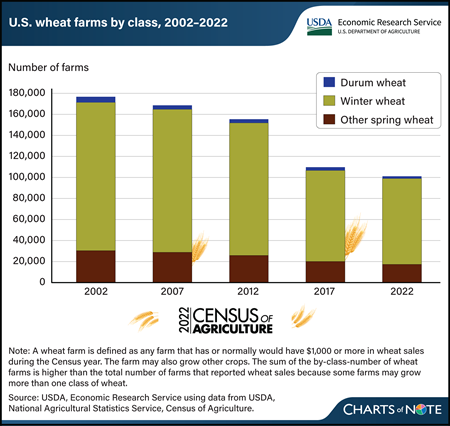
Wednesday, April 3, 2024
The number of farms producing wheat for grain declined substantially from 2002 to 2022, according to new data from USDA, National Agricultural Statistics Service (NASS) 2022 Census of Agriculture. In 2022, the number of U.S. farms reporting wheat production was 97,014, a 43-percent decrease compared with the 2002 census, when 169,528 farms reported wheat production. The reduction in the number of farms producing wheat was spread across all classes of wheat. The number of farms producing winter wheat—84 percent of U.S. wheat farms in 2022—dropped by nearly 60,000, or 42 percent, between the 2002 and 2022 censuses. Farms producing durum wheat decreased by the largest percentage, down 59 percent from 2002. The number of farms growing spring wheat (other than durum) declined 43 percent from 2002 to 2022. During the same time period, total volume of U.S. wheat produced trended down slightly, largely because of less acreage being harvested. As the profitability of other crops rises, wheat is increasingly planted in rotation with more profitable corn or soybean crops. Among major wheat-producing States, Kansas, which accounts for 15 percent of all U.S. wheat farms, saw a reduction of 9,716 farms—a 40-percent decrease from 2002 to 2022. Texas and Oklahoma reported decreases of 54 and 47 percent, respectively, between 2002 and 2022. Together, these 3 States harvested nearly 32 of percent of the volume of winter wheat produced in 2022, according to data reported by NASS in the Small Grains Annual report. For more details on the 2022 Census of Agriculture, see the NASS Census of Agriculture website. Information on trends in the wheat production sector can be found in the special article, “U.S. Census of Agriculture: Highlighting Changing Trends in Wheat Farming” in USDA, Economic Research Service’s March 2024 Wheat Outlook.
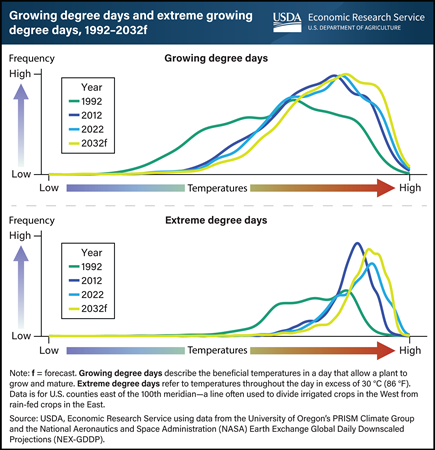
Tuesday, December 5, 2023
According to weather data from National Aeronautics and Space Administration (NASA), temperatures in the Corn Belt, a region spanning across Illinois, Indiana, Iowa, Michigan, Minnesota, Missouri, Ohio, and Wisconsin, have trended higher in recent years and are projected to continue to rise through the end of this century. Two measures can be used to capture how rising temperatures affect crops’ growth—growing degree days and extreme degree days. Growing degree days describe the beneficial temperatures in a day that allow a plant to grow and mature. With rising temperatures, the growing degree days for corn and soybeans increase. A crop’s exposure to added growing degree days is not necessarily harmful; after all, crops need heat and precipitation to grow. However, extreme degree days, which refer to temperatures throughout the day in excess of 30 °C (86 °F), cause heat stress that is harmful for a plant. Each decade since 1992, both growing degree days and extreme degree days have steadily increased with rising temperatures in the Corn Belt, where about 80 percent of all U.S. corn and soybeans are grown. In the decade leading to 2032, both measures are projected to continue to increase. This chart first appeared in the USDA, Economic Research Service report, Estimating Market Implications From Corn and Soybean Yields Under Climate Change in the United States, published in October 2023.
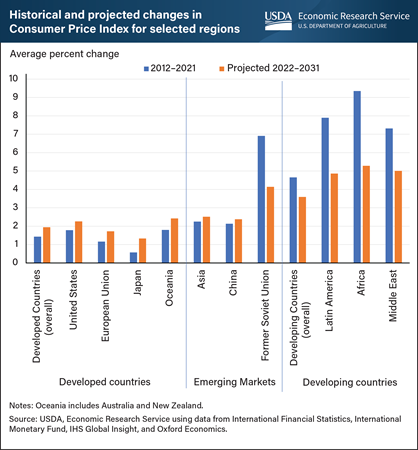
Friday, February 18, 2022
The Consumer Price Index (CPI), a common measure of inflation, is used by economists to reflect underlying conditions that drive changes in the supply, use, and prices of commodities, both domestically and globally. Each fall, USDA forecasts CPI by country and region in addition to other macroeconomic variables as part of the International Macroeconomic Data Set, released publicly the following January. Those variables help form the foundation for USDA’s Baseline, a set of 10-year projections for major crop and livestock commodities released each February. USDA Baseline projections indicate that for the next 10 years, the CPI for developed countries is expected to increase at a rate of 1.9 percent, compared with the previous decade’s growth of 1.4 percent. For developing countries, CPI will continue to grow at 3.6 percent annually over the next 10 years, but at a slower pace than the 4.6 percent from the previous decade. While these projections were established in late 2021, expectations for inflation over the next decade closely mirror those here. In early months of the Coronavirus (COVID-19) pandemic, inflation rates increased significantly more in developing countries but have begun to return to pre-pandemic levels. Central banks have established monetary policies with firm inflation targets, influencing borrowing and lending attitudes in local economies and further slowing inflation. In developed countries, however, inflation rates are increasing and are not projected to revert to pre-pandemic levels at this time. In the United States, changes in lending and purchases of U.S. government and mortgage-backed securities that occurred in the early months of the pandemic have caused expectations to remain slightly elevated when compared to the previous decade. The data in this chart appear in the "International Macroeconomic Data Set," published on January 13, 2022. The full report, USDA Agricultural Projections to 2031, was released on February 16, 2022.
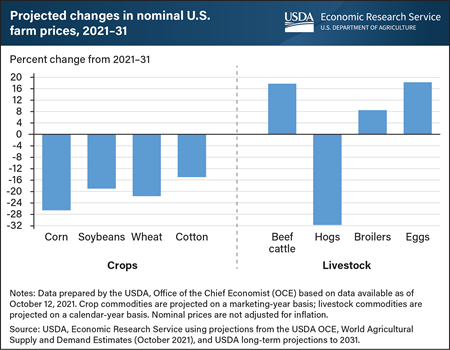
Wednesday, November 17, 2021
Recently released USDA projections reveal expectations for U.S. crop prices to decrease over the next 10 years while prices for major animal products, except hogs, are forecast to increase. Expected declines for crops follow a period of generally higher prices that have peaked during the current marketing year. The price-bolstering effects of economic recovery, renewed export demand, and logistical problems in supply chains are forecast to subside after the recent peak during the 2021/22 marketing year, and crop prices are forecast subsequently to return to the earlier pattern of generally lower prices through 2031. Hog prices are projected to follow a similar pattern to crops and to move toward levels that reflect normal weather and an absence of major market shocks including policy changes. Beef cattle and broiler prices are expected to demonstrate a modest increase in the early years of the projection period before leveling off to slower growth, resulting in an average price increase of 8 to 17 percent over the decade. Similar to most animal products prices, prices that farmers are expected to receive for their eggs are forecast to rise steadily throughout the projection period, partly based on increased demand for cage-free eggs and regulatory changes that are projected to increase costs of production. This chart is based upon forecasts and projections using data available as of October 12, 2021, and long-term projections to 2031 released on November 5, 2021. Current projections are shown in the Economic Research Service’s (ERS) Agricultural Baseline Database. For 2020’s farm price projections, see the ERS Chart of Note from November 9, 2020.
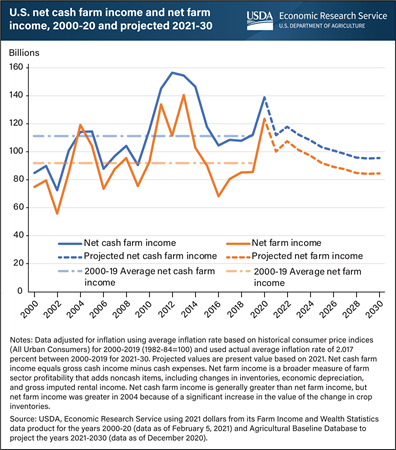
Friday, May 14, 2021
USDA, Economic Research Service (ERS) provides estimates, forecasts, and projections for net cash farm income and net farm income—two major profitability indicators of the financial health of the U.S. agricultural sector. Net farm income is a broader measure of farm sector profitability that incorporates noncash items, including changes in inventories, economic depreciation, and gross imputed rental income. Net cash farm income, on the other hand, includes only gross cash income minus all cash expenses. Net cash farm income and net farm income estimates will not be available for 2020 until September 2021, but forecasts are available. In 2020, ERS forecasts net farm income to be at $123 billion, which was $31 billion more than the 20-year average and $38 billion (or 44 percent) higher than in 2019. ERS forecasts for net cash farm income in 2020 is close to $139 billion. This amount was $43 billion more than the 20-year average from 2000-2019 and $27 billion (or 25 percent) more than in 2019. ERS forecasts that both indicators increased significantly in 2020 as direct government payments to farm operations reached their highest level ever because of COVID-19 related aid, such as the Coronavirus Food Assistance Programs (CFAP) and the Paycheck Protection Program (PPP). In 2021, ERS projects direct government payments to fall, pushing down both profitability indicators. Further projections estimate these profitability indicators to rise in 2022, then level off through 2030 because of a projected increase in production expenses. In 2030, both measures of farm income are projected to be lower than their 2020 forecasts. Net farm income is projected to remain slightly higher than the recent 20-year average, but net farm cash income is projected to be lower for 2021-30. This chart is based on data found in the ERS data products Farm Income and Wealth Statistics and Agricultural Baseline Database, updated February 2021.
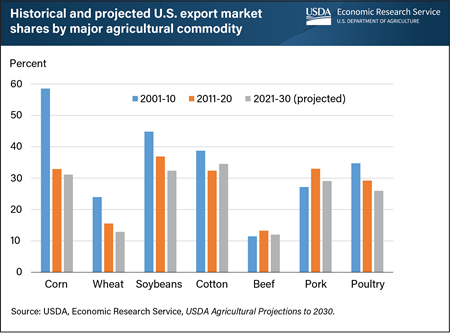
Friday, February 26, 2021
U.S. agricultural exports generate economic benefits beyond the agricultural sector as well as provide support for farm prices and farm income. While the volume of agricultural exports is projected to expand during 2021-30, U.S. exports of major crop and livestock commodities are also expected to face stiff competition from other exporters, particularly Brazil and the European Union (EU). U.S. exports of corn and cotton are expected to remain the largest in the world, but average U.S. world export market shares for nearly all commodities are expected to slip during the next decade compared with the previous decade. Brazil is expected to feature strongly in the competitive outlook. The country is expected to expand its planted area, which would support increased export market shares for a variety of commodities, including corn, soybeans, and cotton, as well poultry, beef, and pork. The EU is expected to further expand its role as the world’s largest pork exporter and, along with Ukraine, boost market share in wheat by exploiting its proximity to major wheat markets. In the United States, only cotton is expected to strengthen in market share, despite competition from Brazil, India, and the Economic Community of West African States. This chart is drawn from data in the USDA report, USDA Agricultural Projections to 2030, released in February 2021.
See also: Economic recovery, competition shape projections of U.S. farm prices to 2030 and
Economic growth of developing countries projected to support U.S. agricultural export gains.
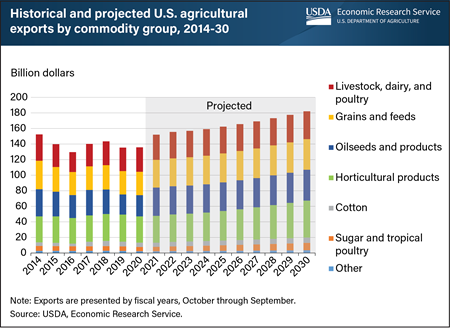
Wednesday, February 17, 2021
U.S. agricultural exports in fiscal year 2021 are expected to increase to $152 billion, up 12 percent from the previous year, and nearing the record set in 2014. Through 2030, exports are expected to grow 1.9 percent annually as the world’s economies rebound from the COVID-19 pandemic, resuming an expansion near the pre-pandemic growth path. Key to these trade projections are the outlook for the rebound and the longer-term resumption of robust economic growth in Asia, Africa, the Middle East, and Latin America, important developing country markets where food import demand is most sensitive to rising incomes. Rising 2021 export values are also supported by higher near-term prices for a range of commodities, including soybeans, cotton, wheat, and meat products. The near-term price trend is anticipated to be followed by generally stable prices through 2030. High-value products, a category that includes horticultural and animal products, as well as processed and semi-processed grains and oilseeds, accounted for 69 percent of U.S. agricultural exports in 2020. That share is expected to drop to 64 percent in 2021 as export values of bulk commodities such as soybeans, cotton, and wheat surge. Exports of high-value agricultural products are expected to resume outpacing the growth in bulk commodities in fiscal years 2022 through 2030, while foreign competition is projected to continue to limit growth in U.S. bulk commodity exports over that same time period. This chart is taken from USDA Agricultural Projections to 2030, released in February 2021.
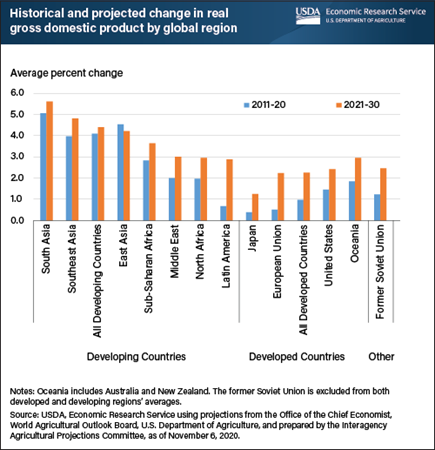
Friday, February 12, 2021
Current USDA projections indicate that, despite the negative impacts of COVID-19 on global economies in 2020, average rates of economic growth are expected to strengthen across most global regions during 2021-30 compared with the previous decade. Key for U.S. agriculture is higher projected growth in incomes—as measured by changes in real Gross Domestic Product (GDP)—in developing regions. Income gains and dietary shifts in these regions drive most of the growth in global import demand for U.S. agricultural commodities. Projections indicate higher gains in incomes across developing country regions, including South and Southeast Asia, the Middle East, North Africa and Latin America. Slower projected growth in East Asia reflects an anticipated continued deceleration in China’s growth during 2021-30, although it will remain one of the world’s fastest growing economies. Developing countries in all regions experienced major pandemic-related contractions in GDP in 2020, but most are forecast to recover in 2021. Uncertainty in the pace of disease control and the length of economic recovery may lead to changes in the 2021-30 outlook for some countries, however. The data in this chart appear in the “Early-Release Tables from USDA Agricultural Projections to 2030,” published on November 6, 2020, and are accessible via the Economic Research Service Agricultural Baseline topic page. The full report, USDA Agricultural Projections to 2030, will be released on February 16, 2021.
See also: Economic recovery, competition shape projections of U.S. farm prices to 2030
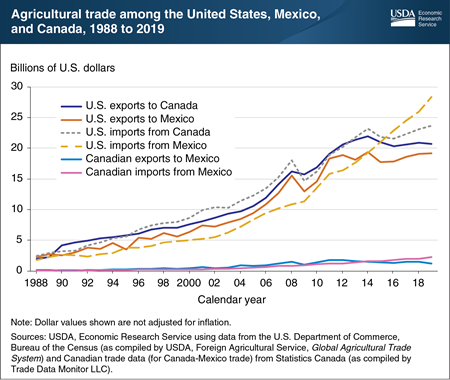
Monday, July 20, 2020
The United States-Mexico-Canada Agreement (USMCA) is a new economic and trade agreement that modifies the terms of the North American Free Trade Agreement (NAFTA), adding provisions for continued growth in agricultural trade among the three member countries. Agriculture has a large and growing stake in interregional trade in the free-trade area created by NAFTA. The total value of intraregional agricultural trade (exports and imports) among all three NAFTA countries reached about $95.3 billion in 2019, compared with $16.6 billion in 1993 (the year before NAFTA’s implementation). Even after taking the effects of inflation into account, this expansion corresponds to an increase in intraregional agricultural trade of 252 percent. Under the ratified new agreement, which took effect on July 1, 2020, all agricultural products that had zero tariffs under NAFTA will continue to have zero tariffs under USMCA. The USMCA adds provisions on biotechnology; geographical indicators; and sanitary and phytosanitary measures, which are measures to protect humans, animals, and plants from diseases, pests, or contaminants. It also provides broader market opportunities for U.S. exports to Canada of dairy, poultry, and egg products. These new provisions, coupled with the continuation of intraregional free trade in almost all agricultural products, provides the foundation for further agricultural trade growth among the United States, Mexico, and Canada. This chart appears in the Economic Research Service’s Amber Waves article, “United States-Mexico-Canada Agreement (USMCA) Approaches the Starting Block, Offers Growth Opportunities for Agriculture.”
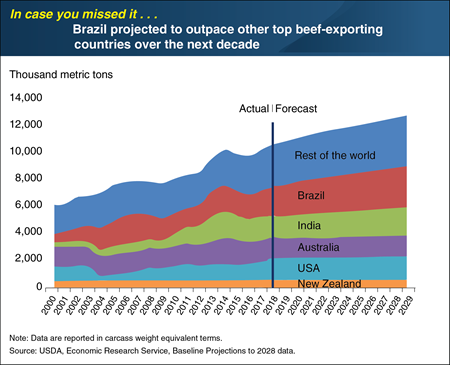
Thursday, December 12, 2019
In 2018, Brazil was the world’s largest exporter of beef, providing close to 20 percent of total global beef exports, outpacing India, the second-largest exporter, by 527,000 metric tons carcass weight equivalent (CWE). Moreover, USDA projects that Brazil will continue its export growth trajectory for the next decade, reaching 2.9 million metric tons, or 23 percent of the world’s total beef exports, by 2028. Increased beef demand worldwide has encouraged increased production. China and Hong Kong remain the top two destinations for Brazil’s beef exports, accounting for 44 percent of Brazil’s total beef shipments in 2018. China in 2012 lifted a Bovine Spongiform Encephalopathy (BSE)-related ban on Brazilian beef and has since become a top importer. With an increase in the number of Brazil’s beef plants authorized to export to China, exports are expected to increase further in 2019 and over the next decade. In comparison with Brazil, the United States ranks fourth in global beef exports and represented 14 percent of total beef exports in 2018. This chart appears in the July 2019 Amber Waves article, “Brazil Once Again Becomes the World’s Largest Beef Exporter.” This Chart of Note was originally published July 15, 2019.
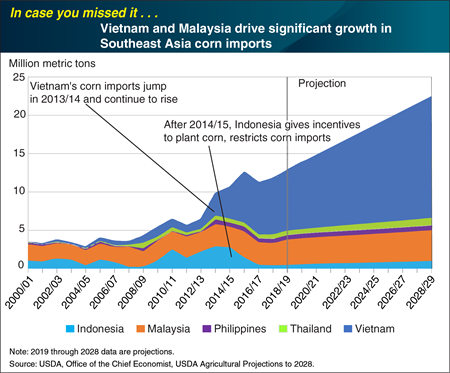
Thursday, November 7, 2019
Southeast Asia’s expanding population and increasing incomes, urbanization, and retail sectors are contributing to rising meat consumption and growing imports of feedstuffs. In addition to soybean meal, corn is a significant ingredient in animal feed, and corn imports are of growing importance to the region. USDA projects that Southeast Asia’s corn imports will grow by 8.7 million metric tons between the 2018/19 and 2028/29 marketing years to reach 22.9 million metric tons by 2028/29. Most of the growth is driven by Vietnam and Malaysia, the fastest growing corn-importing countries in the region. Malaysia produces almost no corn and relies exclusively on imports to meet the feed needs of its steadily growing poultry and egg industries. Vietnam has quickly grown into the largest corn importer in the region, importing 9.5 million metric tons in 2018/19. Since 2012, Vietnam has moved from the 19th-largest corn importer in the world to the 5th largest. Imports are projected to continue to rise and reach 14.9 million metric tons by 2028. In contrast to the growth seen in Malaysia and Vietnam, Indonesia’s corn imports have contracted since 2014/15 due to Government policies aimed at encouraging domestic corn production. This chart appears in the April 2019 Amber Waves article, “Southeast Asia’s Growing Meat Demand and Its Implications for Feedstuffs Imports.” This Chart of Note was originally published April 8, 2019.
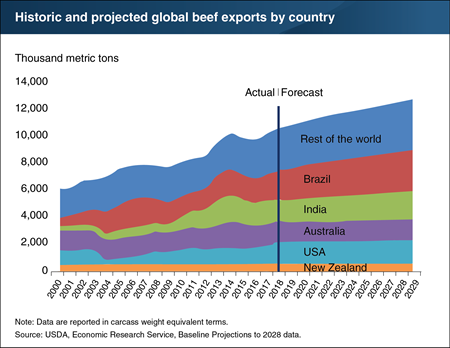
Monday, July 15, 2019
In 2018, Brazil was the world’s largest exporter of beef, providing close to 20 percent of total global beef exports, outpacing India, the second-largest exporter, by 527,000 metric tons carcass weight equivalent (CWE). Moreover, USDA projects that Brazil will continue its export growth trajectory for the next decade, reaching 2.9 million metric tons, or 23 percent of the world’s total beef exports, by 2028. Increased beef demand worldwide has encouraged increased production. China and Hong Kong remain the top two destinations for Brazil’s beef exports, accounting for 44 percent of Brazil’s total beef shipments in 2018. China in 2012 lifted a Bovine Spongiform Encephalopathy (BSE)-related ban on Brazilian beef and has since become a top importer. With an increase in the number of Brazil’s beef plants authorized to export to China, exports are expected to increase further in 2019 and over the next decade. In comparison with Brazil, the United States ranks fourth in global beef exports and represented 14 percent of total beef exports in 2018. This chart appears in the July 2019 Amber Waves article, “Brazil Once Again Becomes the World’s Largest Beef Exporter.”
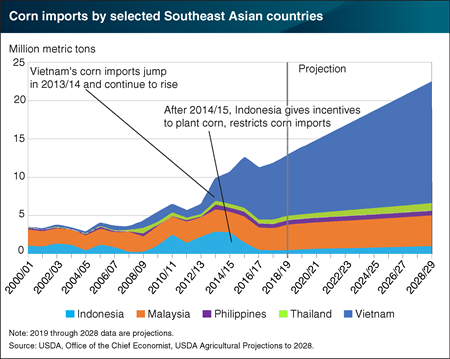
Monday, April 8, 2019
Southeast Asia’s expanding population and increasing incomes, urbanization, and retail sectors are contributing to rising meat consumption and growing imports of feedstuffs. In addition to soybean meal, corn is a significant ingredient in animal feed, and corn imports are of growing importance to the region. USDA projects that Southeast Asia’s corn imports will grow by 8.7 million metric tons between the 2018/19 and 2028/29 marketing years to reach 22.9 million metric tons by 2028/29. Most of the growth is driven by Vietnam and Malaysia, the fastest growing corn-importing countries in the region. Malaysia produces almost no corn and relies exclusively on imports to meet the feed needs of its steadily growing poultry and egg industries. Vietnam has quickly grown into the largest corn importer in the region, importing 9.5 million metric tons in 2018/19. Since 2012, Vietnam has moved from the 19th-largest corn importer in the world to the 5th largest. Imports are projected to continue to rise and reach 14.9 million metric tons by 2028. In contrast to the growth seen in Malaysia and Vietnam, Indonesia’s corn imports have contracted since 2014/15 due to Government policies aimed at encouraging domestic corn production. This chart appears in the April 2019 Amber Waves article, “Southeast Asia’s Growing Meat Demand and Its Implications for Feedstuffs Imports.”
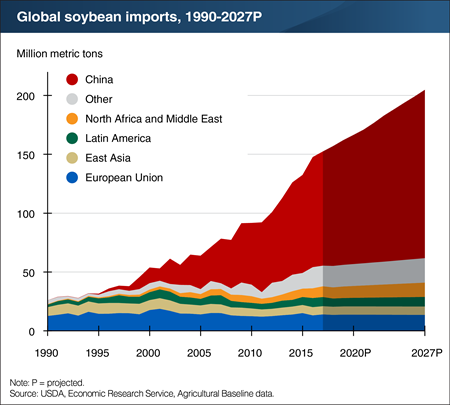
Friday, March 9, 2018
World soybean trade is projected to rise rapidly during the next 10 years according to USDA’s Agricultural Projections to 2027, climbing 48 million tons (30 percent) to 205 million tons by 2027. China, the world’s leading soybean importer, is expected to increase imports by 41 million tons over the projection period. China’s soybean imports have risen steadily since the late 1990s. In 2017, China accounted for about 64 percent of world soybean trade. China’s imports are projected to increase from 102 million tons in 2018 to 143 million tons in 2027, accounting for 86 percent of the total increase in trade. China’s share of global soybean imports would reach nearly 70 percent by 2027 if the projections are realized. The projections assume that China will continue to meet rising demand for edible vegetable oils and protein in feed by importing soybeans, while supporting domestic production of food and feed grains. China continues to add oilseed-crushing capacity that contributes to continued growth in soybean imports. The leading international soybean suppliers are Brazil and the United States, both of which should benefit from the additional demand from China and other trade partners. This chart is drawn from data in the USDA report, USDA Agricultural Projections to 2027, released in February 2018.
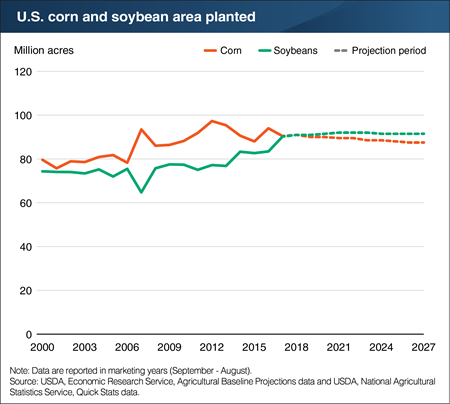
Monday, February 26, 2018
For the first time, the area of soybeans planted in the United States is expected to exceed the area planted for corn in USDA’s newly released Agricultural Projections to 2027. The two crops are the most widely produced in the United States, accounting for more than half of all acres planted. There are many reasons for the growth in soybean area relative to corn. Corn production has benefited from sustained growth in yield per acre, allowing farmers to dedicate less land to corn while maintaining the same output. While soybean yields also improved, the relative gains are not as large. As corn yields grow, overall area planted to corn is projected to trend lower. Additionally, soybean demand is heavily tied to domestic and international demand for meat. Soybean meal is a primary component of animal feeds across species. Rising incomes in many emerging economies have translated to increased meat consumption and international demand for soybeans. This rising demand is expected to place upward pressure on soybean prices and increase producer return, incentivizing further plantings. This chart is drawn from data in the USDA report, USDA Agricultural Projections to 2027, released in February 2018.
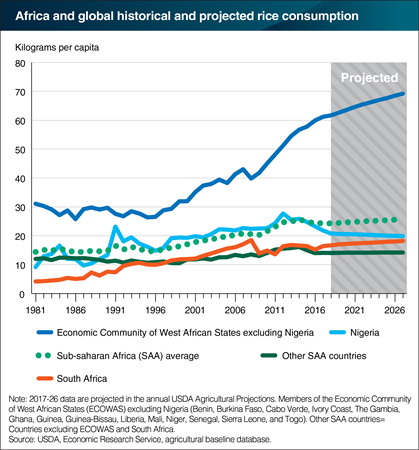
Friday, October 20, 2017
Sub-Saharan Africa (SSA) has undergone economic, social, and demographic transformations over the past 10-15 years. Among the poorest regions in the world, it faces major political and economic challenges and low food security. However, it has a young, fast-growing population and prospects for economic growth. Expanding urbanization and a rising middle class with higher incomes are driving changes in consumption patterns and preferences away from traditional staples and toward rice and other commodities. Rice consumption has expanded in the diets of many SSA consumers at the expense of sorghum, millet, and roots and tubers. On a per-capita basis, West African nations, collectively known as the Economic Community of West African States (ECOWAS) have seen the largest increases in rice consumption. Excluding Nigeria, which reduced its rice consumption because of declining oil revenue and limited foreign exchange reserves, the remaining ECOWAS countries recently surpassed the global per capita rice consumption average. These countries are projected to increase their rice consumption further to nearly 70 kilograms per person by 2026. If the projections are realized, SSA as a whole has the potential to become the world’s leading rice importer. This chart appears in the October Amber Waves feature, "Sub-Saharan Africa Is Projected to Be the Leader in Global Rice Imports."
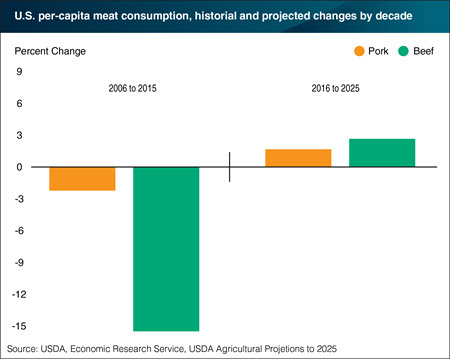
Monday, September 26, 2016
USDA baseline projections provide a long-term view of the U.S. farm sector. These projections show that production of beef and pork will expand steadily between 2016 and 2025, driven by lower feed costs and strong meat demand domestically and abroad. As a result of this greater production, beef and pork prices are projected to drop 10.6 percent and 11.6 percent, respectively, over the same period. Cheaper prices will help reverse a multiyear decline in meat consumption in the United States. Per capita consumption of beef is also forecast to increase 2.7 percent by 2025, outpacing growth in consumption of broilers (2.3 percent) and pork (1.7 percent). USDA expects this will increase the total amount of meat consumed per person in the U.S. from 211 pounds in 2015 to nearly 219 pounds by 2025. This chart appears in the ERS Amber Waves finding U.S. Beef and Pork Consumption Projected to Rebound released September 2016.
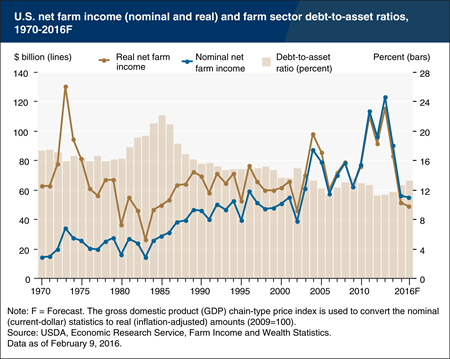
Monday, March 14, 2016
National net farm income, along with the farm-sector debt-to-asset ratio (which is a measure of solvency), provide indicators of the economic well-being of the U.S. farm sector. As of February 9, 2016, U.S. net farm income is forecast to fall to $54.8 billion in 2016 after recently peaking in 2013, due largely to declines in commodity prices. In inflation-adjusted terms, since 1970 only 5 years have registered lower net farm income. With the exception of 2002, all of those years were in the early 1980s, a time of great farm financial stress. The sector’s debt-to-asset ratio has edged up the past several years but at 13.2 percent remains well below the ratio’s 1985 peak. Recent inflation-adjusted debt levels are near, but have not exceeded, early 1980s levels. Thus, the improvement in farm-sector solvency has hinged on farm-sector asset values, which have roughly doubled since 1985 in inflation-adjusted terms. About 80 percent of the value of farm-sector assets are attributable to farm real estate, and both farm real-estate and nonreal-estate assets are expected to experience modest declines in 2015 and 2016. This chart is based on data found in Farm Income and Wealth Statistics, released February 2016.
_450px.png?v=5978.2)
Wednesday, January 13, 2016
The value of the U.S. dollar against other major currencies strengthened considerably in 2015, accelerating a trend that began in 2011. The agricultural trade-weighted exchange rate is a broad measure of the value of the dollar against 79 foreign currencies, weighted by their share of U.S. agricultural exports. The dollar exchange rate affects the price of U.S. commodities in foreign markets, with a stronger dollar making U.S. products more expensive in terms of the local currency of importing countries. On the other hand, a stronger dollar makes U.S. imports less expensive in dollar terms. Since the dollar exchange rate affects the relative price of U.S. and foreign commodities in global markets, it can have important implications for agricultural trade. With the strengthening of the dollar in 2015, agricultural exports are expected to fall below 2014 levels, while imports are forecast to increase. ERS exchange rate projections used for the USDA Agricultural Projections to 2025 report (the current Agricultural Baseline) suggest the dollar will continue to gain strength—but at a slower pace—in 2016 and 2017, before trending lower from 2018 through 2025. This chart is based on the International Macroeconomic Data Set.
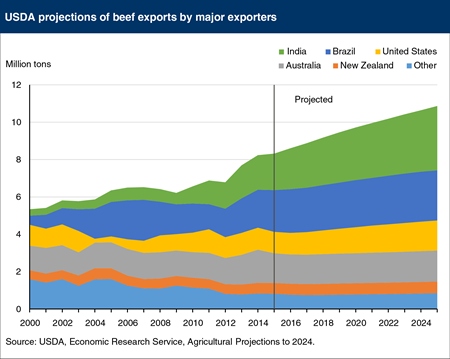
Friday, October 9, 2015
Since 2009, India’s exports of beef—specifically water buffalo meat, also known as carabeef—have expanded, with India moving ahead of Brazil to become the world’s largest beef exporter in 2014. India’s beef exports grew about 14 percent annually between 2000 and 2015, and are expected to lead major exporters with about 6 percent annual growth during 2015-2025. India’s exports of relatively low-cost beef (primarily to low- and middle-income markets in Southeast Asia and the Middle East) reached a 24 percent global market share in 2015, and that share is projected to increase to 32 percent by 2025. The U.S. share of the global beef market has fluctuated, but averaged 12 percent during 2013-2015, and is projected to rise to 15 percent in 2025. This chart is based on data and analysis from USDA Agricultural Projections to 2024.


